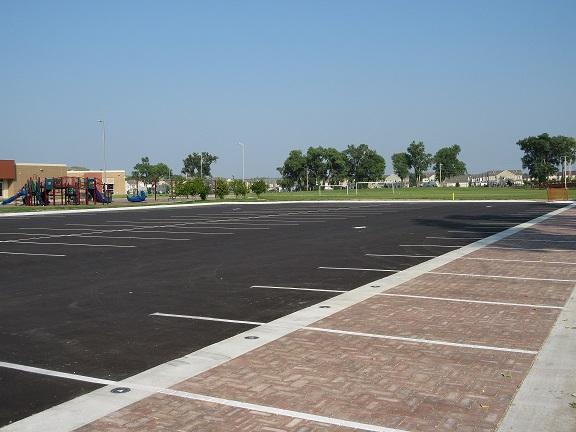Leaving the Gray Behind
(Posted June 24, 2016)
This article is part of a series about EPA's Net Zero program.
Gray Infrastructure–—the gutters, sewers, and tunnels we use to move water away from homes and businesses during a storm–can cause major water pollution and flooding when overwhelmed. EPA’s solution? Green infrastructure.
In urban areas, rain falls onto roofs, streets, and parking lots where it picks up the trash, bacteria, heavy metals, and other pollutants that we leave behind on our streets. This stormwater is then drained from the pavement through storm drains into the sewer system–where it is ultimately treated by wastewater treatment plants. However, during heavy storms, the large amount of rain overloads aging combined sewers, causing the dirty stormwater to overflow into rivers and streams before it can be treated. The completed permeable pavement parking lot behind Seitz Elementary School on Fort Riley.
The completed permeable pavement parking lot behind Seitz Elementary School on Fort Riley.
But rain that falls in natural, undeveloped areas doesn’t pick up pollutants from pavement and doesn’t threaten to overflow our sewers. Instead, it gets absorbed into the ground and is filtered naturally by plants and soil. Green infrastructure, such as green roofs, rain barrels, and rain gardens, uses this natural process. By catching the stormwater for reuse or by allowing it to filter into the ground naturally, green infrastructure helps keep excess stormwater out of sewer drains, keeps polluted water out of our rivers, helps restore the natural water cycle, and helps create healthier urban environments and recharges our groundwater sources.
Researchers with EPA’s Net Zero Program are working with the U.S. Army, U.S. Army Corps of Engineers, Kansas Unified School District 475, and other partners to demonstrate and assess green infrastructure technologies and performance at Fort Riley, an Army base in Kansas.
EPA researchers are testing a permeable parking lot at Seitz Elementary School, which is located on Fort Riley. Unlike traditional roads, permeable pavements are made with porous material so that incoming stormwater can soak through the pavement into the soil. The volume of water that is captured by the parking lot represents the amount of water that is not going to the sewer. Researchers will measure how much rainwater passes through the pavement, how fast the permeable pavement clogs with debris, and changes in groundwater chemistry. They are also monitoring the school’s existing stormwater-capture-use system, which is a set of storage tanks that capture rain runoff. For this part of the study, they are measuring things like the amount of rooftop runoff that is captured and the chemistry of the water stored in the tanks.
This project will not only help researchers test the efficacy of permeable pavements – it will help educate the whole community on green infrastructure and Net Zero.
“The permeable parking lot is different from a lot of other Net Zero research because it is very visible,” says Mike Nye, Acting Net Zero Program Director at EPA. “The community can see that the parking lot looks different from traditional paving, and when it rains, they can actually see it working.”
Because the permeable lot is engaging and has visible results, it is the perfect resource to teach students about the water cycle and water quality. Children at Seitz Elementary School will use EPA’s data in the classroom during STEM lessons.
Nye also considers the collaborative nature of this project to be the future of Net Zero. "By partnering with local stakeholders, specifically with school districts, EPA is making contacts that will be crucial in the future. Once these connections are established, communities will know that EPA is a great resource for help with their sustainability goals."
With the parking lot finally complete and the monitoring equipment installed, EPA is ready to help reduce Fort Riley’s water footprint. But the work’s impact goes beyond Fort Riley: it will provide local governments and communities with more information about green infrastructure technology and will help educate the next generation about sustainability.
Learn More:
- Other articles in this Net Zero Science Matters Series:
- Green infrastructure
- More About Net Zero
- Net Zero Green infrastructure technologies on Fort Riley, KS Fact Sheet
